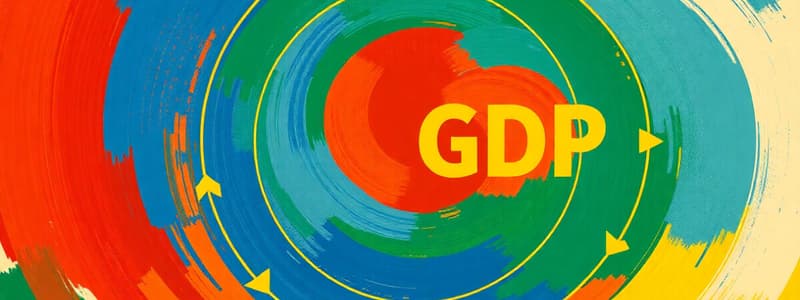Podcast
Questions and Answers
Which of the following accurately represents the flow of money in the economy described?
Which of the following accurately represents the flow of money in the economy described?
- Firms collect income only from the government.
- Households receive wages, pay taxes, and then buy goods. (correct)
- Firms exclusively produce for government consumption.
- Households solely invest money without purchasing goods.
What is the main reason that GDP can be computed in two different ways?
What is the main reason that GDP can be computed in two different ways?
- All expenditure in the economy results in income for someone. (correct)
- Both methods measure consumer satisfaction.
- Households spend equal amounts on goods and services.
- Government spending is the primary driver of GDP.
What role do households play in the circular-flow model?
What role do households play in the circular-flow model?
- Buying goods and services and providing labor to firms. (correct)
- Receiving taxes to fund firm operations.
- Owning all factors of production without exchanging for income.
- Producing goods and services to sell to firms.
What complicates the basic circular-flow model?
What complicates the basic circular-flow model?
If households do not purchase all produced goods, what is one implication for the economy?
If households do not purchase all produced goods, what is one implication for the economy?
Which of the following components is NOT included when calculating GDP?
Which of the following components is NOT included when calculating GDP?
What is the relationship between revenue generated by firms and the payment of wages, rent, and profits?
What is the relationship between revenue generated by firms and the payment of wages, rent, and profits?
What does the circular-flow diagram primarily illustrate?
What does the circular-flow diagram primarily illustrate?
What is the relationship between a nation's GDP and its overall economy?
What is the relationship between a nation's GDP and its overall economy?
Why is it accurate to say that income and expenditure are equal for an economy as a whole?
Why is it accurate to say that income and expenditure are equal for an economy as a whole?
What does the circular-flow diagram illustrate in the context of an economy?
What does the circular-flow diagram illustrate in the context of an economy?
Which statement reflects a misconception regarding GDP?
Which statement reflects a misconception regarding GDP?
What happens to GDP when an individual spends money on services?
What happens to GDP when an individual spends money on services?
In terms of GDP, what is meant by 'total expenditure on the economy's output'?
In terms of GDP, what is meant by 'total expenditure on the economy's output'?
Which aspect is NOT measured by GDP?
Which aspect is NOT measured by GDP?
Why might two individuals with the same income level not have the same economic well-being?
Why might two individuals with the same income level not have the same economic well-being?
Study Notes
Understanding Income and Expenditure
- Economic health can be assessed through income; higher income leads to improved living standards.
- GDP (Gross Domestic Product) is a critical indicator that measures both total income and total expenditure in an economy.
- Income equals expenditure within an economy because every transaction involves a buyer and a seller; spending by one party is income for another.
- Example: If one person pays 100foraservice,GDPincreasesby100 for a service, GDP increases by 100foraservice,GDPincreasesby100, reflecting both consumer expenditure and provider income.
The Circular-Flow Model
- The circular-flow diagram illustrates transactions between households and firms, emphasizing that households buy goods and services while firms pay wages, rent, and profit.
- Money flows continuously: households spend income on goods/services, and firms use revenue to pay their costs, demonstrating the seamless connection between income and expenditure.
- GDP can be computed by summing total household expenditures or total firm income, reinforcing that both methods yield the same GDP figure.
Complications in the Economy
- Real-world economies involve complexities such as taxes, savings, and government expenditures that are not shown in the basic circular-flow model.
- Households generally do not spend all their income due to taxes and savings, while firms may purchase goods and services for future production.
- Despite these complexities, the fundamental principle remains: all expenditures lead to corresponding income, confirming the equality of income and expenditure within an economy.
Studying That Suits You
Use AI to generate personalized quizzes and flashcards to suit your learning preferences.
Description
This quiz explores the concepts of income and expenditure, emphasizing their significance in assessing economic health. It covers the essential roles of GDP and the circular-flow model, illustrating the interconnectedness of households and firms in an economy.



